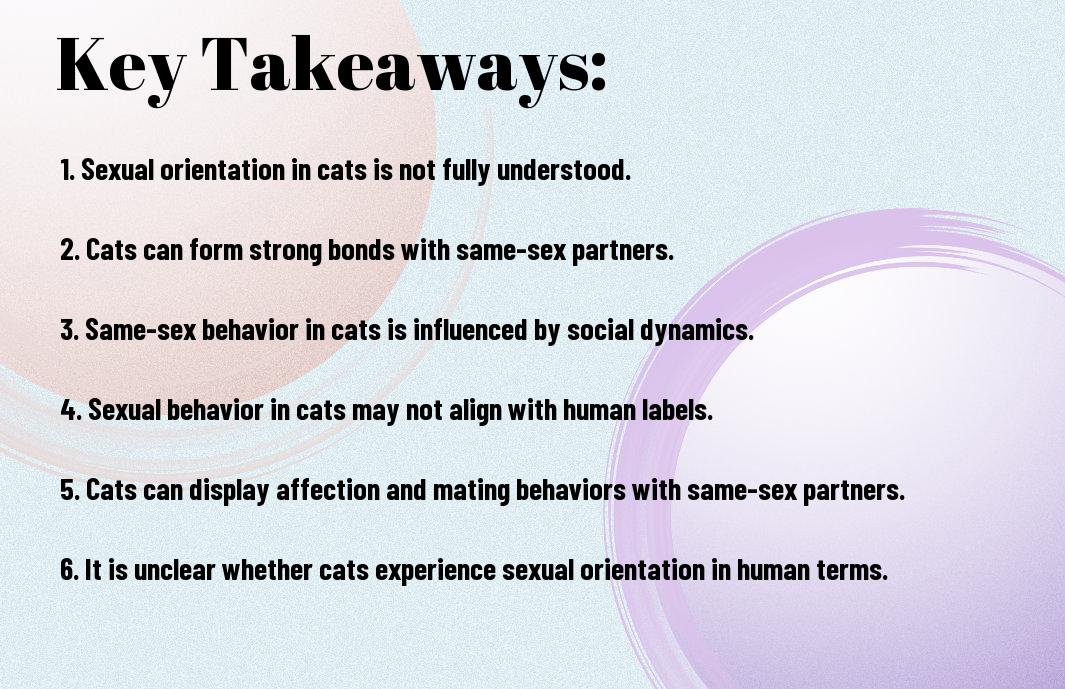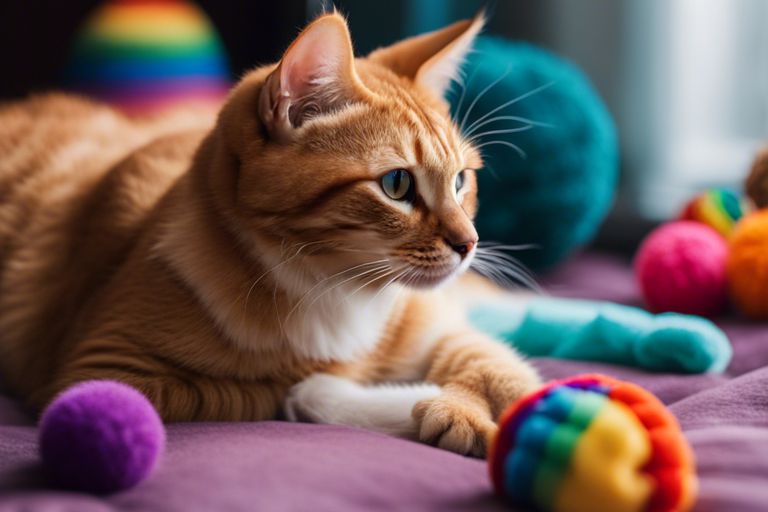Have you ever wondered about the sexual orientation of your feline friend? It’s a question that may have crossed your mind as you’ve observed their interactions with other cats. While it may not be a topic commonly discussed, it’s important to understand that sexual orientation in cats is a real phenomenon. The truth is, just like humans, cats can exhibit homosexual, bisexual, and lesbian behaviors. This can include mating, courting, and forming strong bonds with cats of the same sex. Understanding this aspect of feline behavior can help you better comprehend and appreciate the complexity of your beloved pet.

Understanding Animal Sexuality
Some people may wonder if animals can have sexual orientations like humans. The reality is that animals do exhibit a wide range of sexual behaviors, and the concept of sexual orientation in the animal kingdom is a topic of ongoing research and debate. Understanding animal sexuality can help us see how diverse and complex sexual behaviors can be in the natural world.
Scientific Perspective on Animal Sexual Behaviors
In the scientific community, there is a growing body of evidence that suggests many animals engage in same-sex sexual behaviors. This can include courtship, mounting, and even forming long-term same-sex partnerships. These behaviors have been observed in a wide variety of species, from mammals to birds and even insects. While the reasons for these behaviors are not fully understood, studies have shown that they can serve various social and reproductive functions within animal populations. It is important to approach this topic with an open mind and recognize the complexity of animal sexual behaviors.
The Concept of Sexual Orientation in Animals
Despite the existence of same-sex sexual behaviors in animals, the concept of sexual orientation as it is understood in humans is still a subject of debate in the scientific community. While some researchers argue that animals can indeed have a sexual orientation, others emphasize that animal behaviors may not align with human concepts of sexual identity. The key takeaway is that animal sexuality is diverse and can’t be easily categorized into human terms. The most important thing is to respect and understand the natural behaviors of animals, rather than imposing human labels on them.
Observations of Same-Sex Behavior in Cats
One of the most intriguing aspects of feline behavior is the observation of same-sex interactions. If you are a cat owner, you may have noticed instances where your cat displays affection or engages in mating-like behaviors with other cats of the same sex. These behaviors can sometimes be mistaken for mating rituals, but they can also be purely social or affectionate in nature.
Historical and Contemporary Reports
Throughout history, there have been numerous reports of same-sex behavior in cats. Ancient Egyptian hieroglyphics and artwork depict cats engaging in same-sex interactions, indicating that this behavior has been observed for thousands of years. In contemporary times, many cat owners and animal behavior experts have reported instances of same-sex bonding and affection in domestic cats. This behavior is not exclusive to any particular breed or gender, and can be observed in both male and female cats.
Analyzing the Motivations Behind Feline Same-Sex Interactions
When analyzing the motivations behind feline same-sex interactions, it’s important to consider that cats are social animals with complex social structures. Same-sex interactions may serve as a way for cats to establish and maintain social bonds within their group. Additionally, same-sex affection and grooming behaviors may also serve as a form of stress relief and emotional support for cats. It’s crucial to remember that these behaviors are not strictly sexual in nature and can be attributed to a variety of social and emotional factors.
In conclusion, it’s important to acknowledge and understand the complexities of feline same-sex behavior. While it may not fit traditional human-centric definitions of sexual orientation, same-sex interactions in cats play an important role in their social and emotional well-being. As a responsible cat owner, it’s essential to provide a supportive and accepting environment for your feline companions, regardless of their sexual behaviors. Understanding and accepting these behaviors can contribute to a healthier and happier relationship with your cats.

Exploring the Term “Gay” in the Context of Animal Behavior
Unlike humans, animals do not have the capacity for self-identification or the ability to communicate their sexual orientation. As a result, applying the term “gay” to animal behavior can be a controversial and complex topic.
The Challenge of Applying Human Labels to Animal Actions
When discussing the concept of homosexuality in animals, it’s important to recognize the limitations of applying human labels to their behavior. Animals engage in a wide range of mating and bonding behaviors, and it can be misleading to impose human sexual orientation categories onto them. While some animals may engage in same-sex behaviors, it doesn’t necessarily mean that they have the same understanding of sexual orientation as humans do.
Anthropomorphism and Its Impact on Our Understanding
Anthropomorphism, or the tendency to attribute human characteristics to animals, can greatly impact our understanding of their behavior. When discussing the concept of gay, bisexual, or lesbian behavior in animals, it’s crucial to avoid projecting human social and cultural constructs onto their actions. Instead, it’s important to approach the topic from a biological and behavioral standpoint to gain a more accurate understanding of their actions.

Biologically Driven Behaviors vs. Sexual Identity in Cats
For cats, sexual behaviors are often driven by instinct and biological factors rather than a defined sexual identity. While we may attribute human-like sexual orientations to our feline companions, it’s essential to understand the differences between biologically driven behaviors and sexual identity when it comes to cats.
The Role of Reproductive Instincts in Animal Behavior
When it comes to cats, reproductive instincts play a significant role in their behaviors. Male cats often exhibit mating behaviors such as spraying and yowling to attract females during the breeding season. Female cats, on the other hand, may display receptive behaviors and vocalizations to attract males. These instincts are biologically driven and serve the purpose of perpetuating the species. It’s important to recognize that these behaviors are not indicative of a cat’s sexual identity but rather their natural instincts.
The Difference Between Human and Animal Sexual Identity
It’s crucial to understand that the concept of sexual identity in animals is not the same as in humans. While humans may experience sexual orientation and identity, animals, including cats, operate on a more instinctual level when it comes to mating and reproduction. They do not form long-term romantic partnerships or exhibit sexual preferences based on gender identity. Instead, their behaviors are predominantly driven by biological and environmental factors, rather than a defined sexual identity.
Wrapping Up
So there you have it – cats, like humans, can exhibit same-sex behaviors, but it’s not necessarily tied to sexual orientation in the same way it is for humans. Cats may form close, affectionate bonds with other cats regardless of their gender, and these bonds can sometimes appear to mirror human romantic relationships. While cats may engage in same-sex behaviors, it’s important to remember that they do not have the same social constructs and concepts of sexual orientation as humans do. So while your cat may exhibit behaviors that resemble homosexuality or bisexuality, it’s best to recognize that this behavior is not necessarily indicative of a cat’s sexual orientation in the same way it is for humans. Ultimately, what’s most important is that you provide a loving and supportive environment for your feline companion, regardless of their behavior.
FAQ
Can cats be gay, bisexual, or lesbian?
While there is evidence of same-sex behaviors in cats, it’s important to understand that sexual orientation as humans understand it may not directly apply to animals. Same-sex behaviors in cats are often a display of dominance, establishing territory, or forming close social bonds. It’s not accurate to label a cat as gay, bisexual, or lesbian as these are human terms that don’t fully encompass the complex behaviors of animals.
What are some examples of same-sex behaviors in cats?
Same-sex behaviors in cats can include mutual grooming, play fighting, and close physical proximity. Female cats may engage in these behaviors as a way to form social bonds and cooperate in raising offspring, while male cats may use them to establish social hierarchy and territory. These behaviors are natural and serve important purposes within the feline social structure.
How can I ensure my cat’s well-being regardless of its sexual behavior?
Regardless of your cat’s sexual behavior, it’s important to focus on providing a safe and enriching environment. This includes regular veterinary check-ups, a balanced diet, plenty of mental and physical stimulation, and a safe space where your cat can feel secure. Additionally, providing social interaction and companionship for your cat can contribute to its overall well-being. Remember that understanding and respecting your cat’s natural behaviors is key to promoting its health and happiness.

Hello there, I am Iftekhar Ahmed. I am the owner of Mishka & The Cat Corners. I love to explore and write on various topics about cats

